Weight is what matters where load area racking systems are concerned, says Jerry Lane, business development manager at Modul-System; and that is especially the case at 3.5 tonnes. “Weight is the most important thing, then price,” he says.
A steady rise in unladen weights in recent years thanks to the arrival of everything from air-conditioning systems to AdBlue reservoirs means that every kilo saved counts.
Fail to pay attention to this requirement and you may be left with next to no payload capacity if you want to remain below the 3.5-tonne barrier.
“Payload is a real issue,” Lane comments.
One operator wasn't a weight-watcher
The penalties for miscalculating can be drastic, and Lane knows of one operator who got it catastrophically wrong. Having had shelving and binning installed along with a large quantity of ancillary equipment – a generator, a hand-wash system, and so on – he was left with a legal payload capability on a 3.5 tonner of just 60kg once its crew was on board.
That need not happen, however, if you specify everything that is fitted carefully and continually watch its weight.
“For example, we’ve been fitting a lightweight, but strong, composite bulkhead to vans used by some of our customers in the parcels industry that saves 40kg,” he says. “The average weight of each of the parcels they transport is 6kg, so that means they can carry getting on for seven more.”
Saving weight does not necessarily mean having drawer units, cupboards and other items made out of aluminium rather than mild steel.
Modul-System makes extensive use of ultra-high-strength steel. It is more expensive than mild steel, but at least four times stronger, which means far less of it has to be used.
Furthermore, it is more robust than aluminium, although the latter, of course, does not corrode.
As Modul-System’s composite bulkhead indicates, other types of material are increasingly being deployed. Sortimo’s fold-away FlexRack shelves make use of composite material too, and Modul-System has come up with a strong, but lightweight, workbench that employs an extruded polystyrene and fibreglass reinforced polyester sandwich.
It is said to be around 60% lighter than an equivalent made from timber.
Kilo comparisons
A 1.5m-long workbench constructed using this type of material and complete with an aluminium edge-protector tips the scales at 7kg, says Modul-System. A wooden one of the same length weighs 19kg, it adds.
Robustness and all-round durability matter if you are aiming to have your shelves switched out of an old van that is being de-fleeted and put into its replacement.
Some fleets have third and even fourth life racking units.
Switching from one make and model of a van to another is not usually a problem provided they are both the same size. Suppliers usually change all the fitting brackets anyway.
So, how long should a system last before it has to be scrapped? “In our case, it’s usually around eight years,” Lane replies.
It may be possible to re-use some of the old racking and introduce some fresh features if a fleet’s requirements have changed.
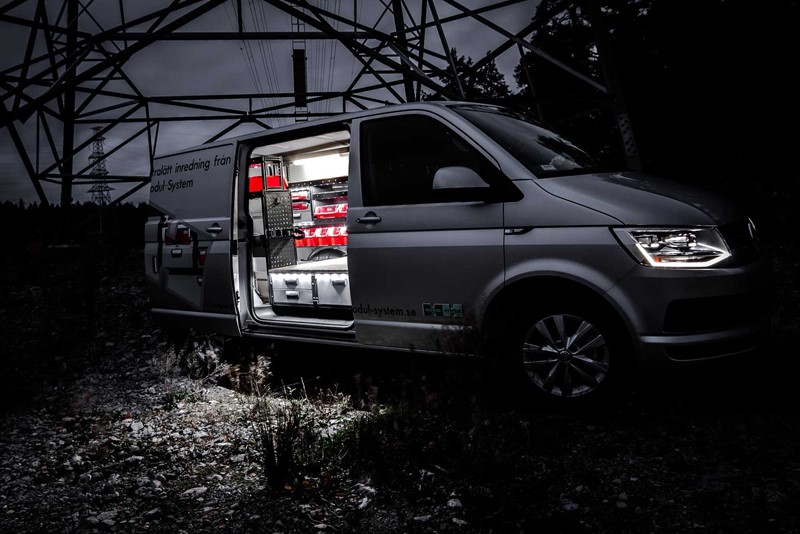 System Edstrom took this approach earlier this year when it kitted out Solihull Community Housing’s 60-plus vans. It has worked with SCH since 2013.
System Edstrom took this approach earlier this year when it kitted out Solihull Community Housing’s 60-plus vans. It has worked with SCH since 2013.
There is no reason why a judicious mixture of materials should not be used in order to bring down weight.
Bodybuilder VFS is now marketing a range of shelves, racks and drawers made by Italy’s Baggio de Sordi from a mix of high-strength steel and aluminium. On the other hand, fellow Italian manufacturer Gentili makes its Infinity racking solely out of extruded anodised aluminium, pointing out that as well as saving weight, it is easy to recycle.
“When it’s time to dispose of it, you simply have to separate the plastic supports from the aluminium frame,” says the company. “Furthermore, the fact that no paint has to be used makes it environmentally-sound.”
Weight can be saved by looking more closely at the design of storage equipment, and modifying it accordingly. Qi Van Systems makes the point that a carefully-designed package may enable an operator to downsize to a smaller van that is more economic to buy and operate without any loss of onboard storage capacity.
Sortimo’s latest generation of SR5 racking is supported by a single aluminium side profile at each end of a run of drawers and shelves plus lashing points embedded in the floor rather than a complex framework. It saves space as well as weight, says the company, and means installations can be completed more quickly.
Shaped to van contours
It is also shaped in line with the contours of the van’s interior, which means it takes up less room. A panel van’s sides are not vertical.
The drawers and storage boxes that are provided can be complemented by a foldable workbench with a vice, and gas cylinders can be lashed to the alloy side profiles. The workbench is integrated into one of the standard shelves, with no need for it to be supported by a separate aluminium up-stand.
Employing strong telescopic slides, some of the drawers can accommodate pieces of equipment weighing up to 100kg.
The majority of mainstream racking suppliers can produce proof that their products have been crash-tested – proof that fleets should always insist on seeing – and are working more closely with van manufacturers.
Ford’s QVM (Qualified Vehicle Modifier) programme embraces Bott, Sortimo, System Edstrom and Vanliners, for example, while Renault’s list of approved converters includes Bri-Stor.
Over the years, racking companies have broadened their product portfolios into areas such as sign-writing, invariably using adhesive vinyl.
System Edstrom’s work for SCH included designing the graphics for its vans. The process was complicated by the need to include warning signs to comply with safety legislation because they may have to carry flammable substances, gases and other hazardous materials.
“What was a simple livery on the vans became a half-wrap and a new corporate identity for them,” says System Edstrom UK managing director Peter Corderey.
Racking firms regularly equip van load areas with an electrical system which can be used to power work lights, for example.
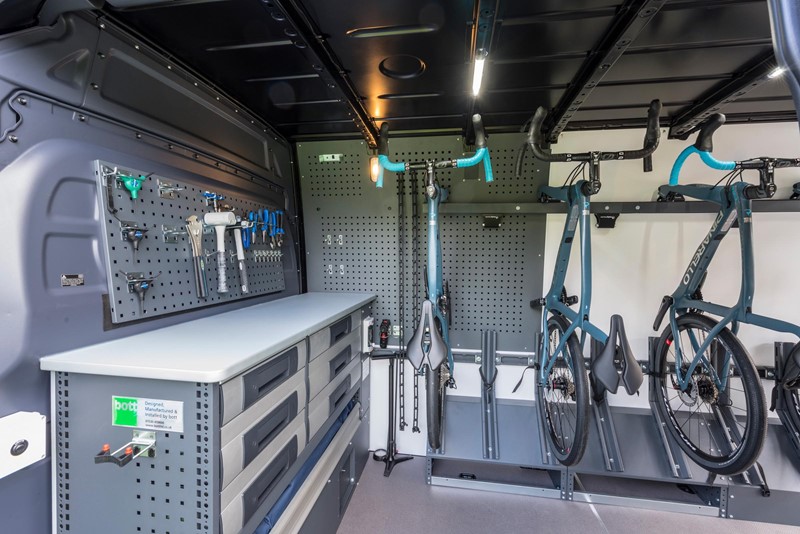
Italian bicycle manufacturer Pinarello, whose racing bikes have been ridden by the likes of Bradley Wiggins, Geraint Thomas and Chris Froome, has had a UK-based Mercedes-Benz Sprinter 3.5-tonner converted into a mobile workshop by Bott.
As well as providing lighting and power, the electrical system that has been fitted to the van allows batteries for e-bikes to be recharged en route. Other features include custom-built racks for up to 20 bikes, storage facilities for promotional gear and display equipment, and an offside awning.
Bott updated the vehicle’s graphics too.
The Sprinter is regularly accompanied by three Mercedes Vitos with a second row of seats and room for up to four bikes apiece.
“Our engineering team created bespoke fixings to suit the bike frames and the vehicles Pinarello is using,” says Bott business development manager, Neil Robson.
Modul-System has come up with Modul-Connect. It is a plug-and-play wiring and control system which uses a unique digital signal to control all the electrical items connected to it.
This allows various items to be powered and switched along the same cable simultaneously.
“The way it is designed means it can be installed quickly and safely, without the need for experienced electricians or complex programming,” says vice-president, Thomas Johansson.
“The time saved will differ between specifications, but it is not uncommon to save up to 40% on installation time compared with traditional wiring,” he adds.
Is any weight saved?
“It has allowed us to lower the wiring weight from 25kg to 5kg for one of our largest utility fleet customers,” he replies.
Install a workshop electrical system in the load area of an electric van and there is a risk that it will deplete the battery pack.
In response, System Edstrom has fitted out an electric Renault Kangoo Van ZE with a separate 100 amp-hour lithium-ion battery which can be used to drive tools.
It can be recharged through a 230v port and receives an average 8amp trickle charge from a solar panel mounted on the vehicle’s roof.
Some specialists in the sector have developed their own compact electric light commercials.
With a top speed of 28mph, Sortimo’s ProCargo CQ1 can be used to transport one of the company’s demountable sContainers.
Suitable for the storage of tools and parts, the lockable container can be left on a construction site so its contents can be used by trades people, then collected once they have completed their tasks.
Fitted with scooter-type controls, and a possible candidate for last-mile delivery work, the little four-wheeler is equipped with lithium-ion phosphate batteries which give it a range of just under 40 miles between recharges.
Modul-System makes the point that the gradual roll-out of electric vans will oblige racking fitters to adopt a different approach to installation if they have not already done so.
Drilling into a van’s floor to fix racking is best avoided in conventionally-powered models if possible because of the risk that the resulting hole will lead to rust and invalidation of the vehicle’s body and paintwork warranty, unless suitable anti-corrosion measures are taken.
With electric vans such drilling will become impossible and potentially dangerous because of the presence of batteries and high-voltage wiring.
Modul-System’s solution is a separate aluminium floor with rails to which equipment can be fixed. Installed in a similar way to parquet flooring, it is glued into place and can be left there when the van is sold.
If rails have to be positioned along the van’s sidewalls then they, too, can be glued into place. Modul-Floor is on average around 20% lighter than a plywood floor, the company claims.
Demand for load bay storage packages is strong at present, says Lane, in line with soaring light commercial registrations year-to-date.
“As far as we’re concerned it’s a booming market,” he comments.
It is a boom Cartwright Conversions, among others, is determined to capitalise on with the establishment of a large new centre on a 26-acre site at Belton in Lincolnshire.
As well as installing racking it carries out a wide variety of other conversion work. Recent projects include building more than 130 patient transport vehicles for Falck Ambulance UK.
WLTP introduction has created lack of clarity among converters
The advent of WLTP (Worldwide harmonised Light vehicle Test Procedure) has significant potential implications for van conversion specialists.
Fit shelving, drawer units and so on and the additional weight they impose should mean that the WLTP figure will change. The problem is that the manufacturer portals and the data required to make the necessary calculations have yet to be put in place all across the industry and many converters admit to being confused about what they should do.
 “There are grey areas and a distinct lack of clarity and everyone is in the same boat,” says Peter Clarke (left), head of customer relations at Qi Van Systems. “Some of the manufacturers have been proactive and we have access to the portals they have put in place, others less so, and some don’t appear to be doing anything.”
“There are grey areas and a distinct lack of clarity and everyone is in the same boat,” says Peter Clarke (left), head of customer relations at Qi Van Systems. “Some of the manufacturers have been proactive and we have access to the portals they have put in place, others less so, and some don’t appear to be doing anything.”
Modul-System’s Jerry Lane says: “In theory everything should have taken off on September 1, but it didn’t, and we’ve been contacting vehicle manufacturers to find out what they’ve got in place. We understand that some of them have websites ready to go, but don’t have all the data required available.
“There are websites in place in other European markets that have yet to be triggered in the UK,” he adds. “I reckon it will be another year before it’s all sorted out.”
In the meantime, Modul-System is continuing to kit out vehicles in the way it has done previously. “As far as we’re concerned, it’s business as usual,” Lane observes.
According to Volkswagen Commercial Vehicles specialist sales manager Nick Axtell there is no need for racking companies or their customers to panic. At least, not yet.
As things stand, he says, the existing N1 Enhancement scheme which covers storage equipment fixed to the load area will remain in force until the end of 2020.
What this means in practice, says Axtell, is that the weight it imposes is treated as payload, and does not affect the WLTP figure. “There is no mechanism for reporting it anyway,” he observes.
So should everybody sigh with relief and move on? Not quite, says Axtell.
The situation could change after 2020 and converters should engage with the Vehicle Certification Agency and the Society of Motor Manufacturers and Traders (SMMT) to ensure they are kept abreast of any developments, he advises. That is especially the case given that a van’s WLTP figure could affect its Vehicle Excise Duty rating in future, he points out.
So are the portals that have been created (VWCV, for example, has one, as does Toyota) pointless at present as far as racking and related equipment are concerned? Not entirely, says Axtell.
“You can have a situation where a fleet wants to ensure the CO2 emissions of each of its vans do not exceed 150g/km because that happens to be its corporate policy,” he explains. The portal can be used to calculate the CO2 impact of fitting particular items and add and subtract them until the right figure is achieved.
“As a guide, every 25kg you add means an extra gramme of CO2,” he says.
What is to stop fleets getting their vans registered first, then having shelf units and flooring installed afterwards?
On the face of it, nothing. Off-the-peg racks can be bought online – the supplier’s website may have a facility which enables you to configure a suitable layout on-screen – and fitted in a local (possibly non-franchised) workshop. Doing so is not illegal.
Compliance issues would make Modul-System wary of any direct involvement in such a post-registration arrangement however, says Lane. It’s a view shared by Clarke.
“Our customers are heavily into health and safety, compliance and duty of care,” Clarke observes. “We wouldn’t want to do anything
to compromise that.”
What buying off-the-peg units would not do is provide a fleet with a purpose-built storage system tailor-made to meet the requirements of its mobile engineers or trades people.
So, such an approach could quickly breed inefficiency and end up being counterproductive.



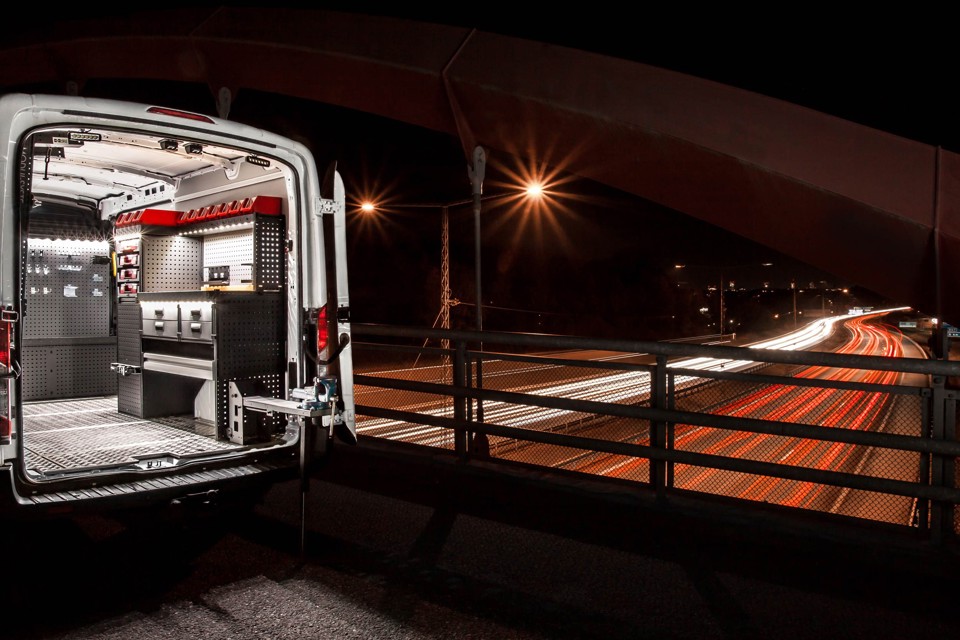














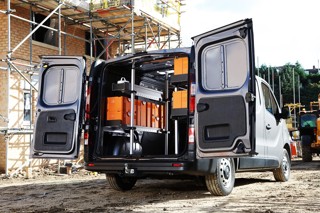
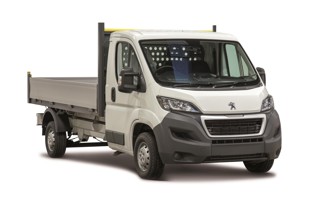
Login to comment
Comments
No comments have been made yet.